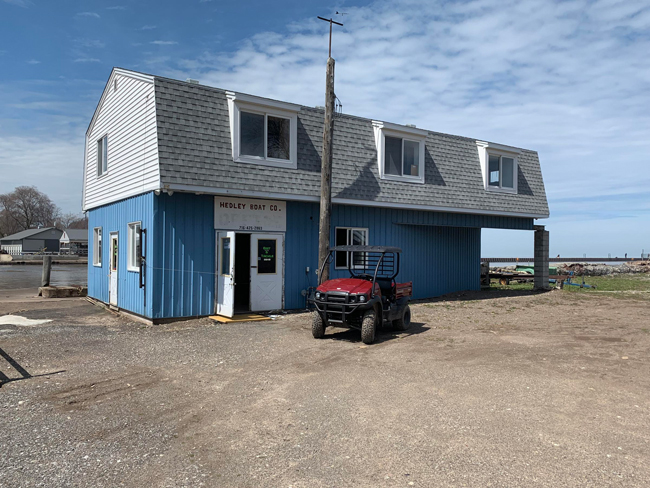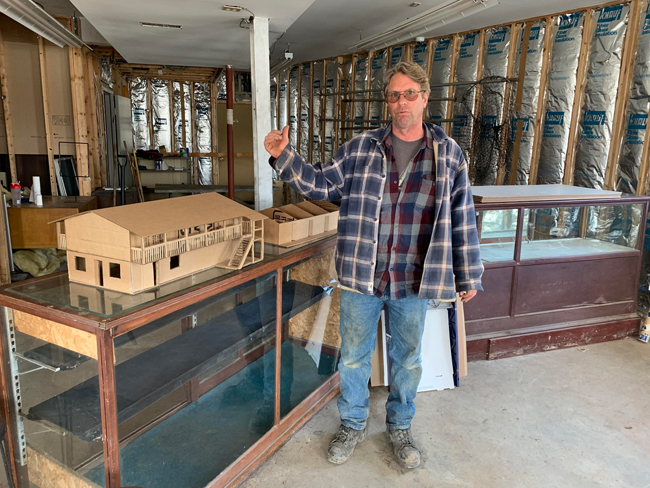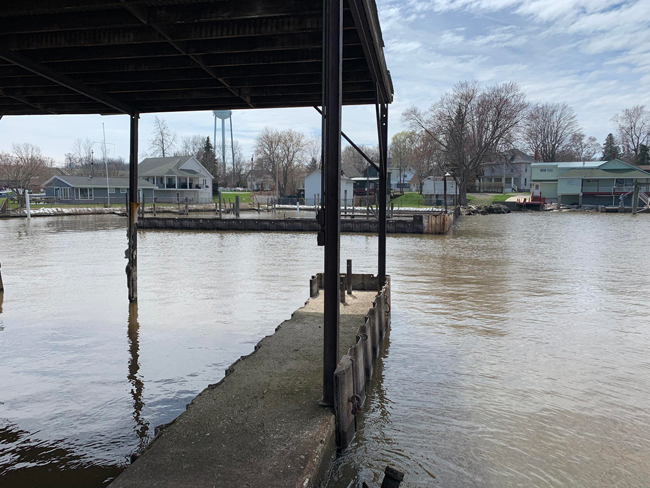
Hedley Boat Company in Olcott, NY. Credit: Nick Lippa / WBFO.
— Filed by Nick Lippa for WBFO 88.7 FM
If you don't see the player above, it's because you're using a
non-Flash device (eg, iPhone or iPad). You can download the mp3 file by clicking here (mp3). It may take a few minutes to download, so please be patient.
Buffalo, NY, May 7, 2019 - Gov. Andrew Cuomo
and public officials around the state continue to blame the
International Joint Committee for the high water levels in Lake Ontario.
While IJC critics point to Plan 2014 being the root of the problem,
other Great Lakes experts say Mother Nature is playing a bigger role. So
what happens next? WBFO’s Nick Lippa visited Olcott to speak with residents and officials about the issue.
Memories of violent 2017 waves linger in the minds of property owners along the Lake Ontario shore. The flooding ended up costing New York State $100 million in recovery funding, but Newfane Town Supervisor Timothy Horanburg said they still haven’t recovered.
“We’re still dealing with FEMA doing some repairs to some municipal walls and stuff that are built along the lake, that we can’t fix because the water has been too high,” he said. “Our roads drain in to Lake Ontario. We have to put road plugs in our drains, because the water starts pushing back coming in to the lower areas in to the streets. Then when it rains, it has no place to go. So we’re just pumping in circles down here.”
Horanburg said town emergency funds have to be allocated primarily for lake flooding.
“We get a certain percentage of reimbursement, but that certain percentage has to come out of our pockets,” Horanburg. “We haven’t finished the repairs from before and to look at that damage happening again, I don’t look forward to it and nor do our residents.”
David Hedley, owner of Hedley Boat Yard, was hit hard in 2017. He is working to keep a business afloat that was founded by his great-grandfather more than 100 years ago.
“He built this boatyard and all of these docks to the old plan,” Hedley said.
The recent plan implemented in 2014 allows for Lake Ontario to fluctuate between higher and lower water levels. So when land owners like Hedley were asked to invest their own money to fix damage done by the lakes in 2017, they became angry.

David Hedley standing in his building, which hasn't fully recovered since 2017 floods. Credit: Nick Lippa / WBFO.
“Why should I take out a loan to repair the damage that was caused by this flood? And this flood is not a natural disaster. It’s not caused by Mother Nature. It’s man-made. They’re holding the water back all winter long. And then when they start letting it out, it’s too late,” Hedley said. “We have 6-8 foot seas on the inner harbor. This is supposed to be a safe refuge harbor. Well, it’s not.”
Hedley was told he was allowed up to $50,000 in aid, but had to spend up to $100,000 to help repair 2017 damages.
“I’ve spent well over that in the last two years. I put new launch ramps in up the creek farther because I can’t haul and launch boats here in the inner harbor because it ruined the old ramps,” he said. “The big logs got underneath them when the water came up, pounded the hell out of them, broke them all loose. Just those ramps alone for that 30-ton hoist to go out on to launch and haul boats? Fifty thousand dollars just for that project.”
“Who is responsible? That’s what I’d like to know.”
Officials like Gov. Andrew Cuomo and Rep. Chris Collins point to the IJC and Plan 2014, but UB’s Great Lakes Program Associate Director Helen Domske, also a senior coastal education specialist with New York Sea Grant program, said it’s more complex than that.
“When we had those floods in 2017, everyone including legislators blamed the IJC for this Lake Ontario plan 2014,” Domske said. “But if you really look at the plan and the science, I think it 20 years of scientific research went in to deciding that plan in consideration and consultation with stakeholders all around the basin. Even the top scientists in the Great Lakes agree that it wasn’t the IJC plan that caused the flooding in 2017. It was the fact that we had this unnatural amount of rain on top of a heavy snow pack that melted. But people have it in their mind that it’s all because of plan 2014. It’s because of Mother Nature.”
Domske said climate change is bringing greater storms [http://glisa.umich.edu/climate/extreme-precipitation], which leads to higher lake levels, something Cuomo recently acknowledged could be “the new norm.”
“I think we had over 60 inches of snow in January. That’s incredible. That’s an incredible amount of snow that has to melt and has to go somewhere,” Domske said.
Domske added it is not accurate to say every year from now on the levels will be higher. She says we could still see years with low water levels, like in 2016 when there was a drought.
“This fluctuation is very normal. It’s not unusual. It just happens to be this spring, we got a big snow melt and a lot of rain,” Domske said. “But again, it is nowhere near 2017.”
Every year, all the excess water from the Great Lakes flows in to Lake Ontario. Lake Superior is only two inches below its record level high for April. The rest of the Great Lakes are at high water levels. This is a red flag for shoreline communities.
But Domske said even if the lake goes up 11 inches in May, it would still be a foot lower than it was in 2017.
“Yes, I can see why people are concerned. I was a homeowner (on Lake Ontario). I had a house. I had a cottage for a number of years and I know what the water levels can do,” Domske said. “But we just hope that Mother Nature doesn’t put forth a big rain storm or a big wind storm that will move that water around and cause additional erosion.”

Newfane Town Supervisor Timothy Horanburg. CCredit: Nick Lippa / WBFO.
More than 800,000 sandbags and hundreds of pumps have been put in place along Lake Ontario. Horanburg says they feel more confident this time around.
“We have some things that we did in 2017 that are still there. We learned form 2017, so I think we’ll have, not an easier time, but it won’t take us as long to respond the right way,” Horanburg said.
Domske and groups like New York Sea Bank are working with communities to plan for sustainability.
“I mean just think about this year as compared to 2017. The towns have sandbags in place. Or at least they know where to get sandbags. The counties are reacting the local towns are reacting, the state itself is reacting.” Domske said. “I think it’s very important for communities to be aware that this may be a new normal with more storms and higher precipitation, but nobody knows for sure.”
Domske said the IJC has the best scientists working on this.
“They’re quite aware of the fact that home owners are suffering in the lake, but they also have to worry about down river flooding,” she said. “So there’s a balance that has to be maintained. And the dams themselves can only take so much water. It’s not like there’s a faucet that can magically make the lake level drop without doing damage downstream. It’s just a matter of elevation. You think about, the water comes from Lake Erie and drops over 200 feet down to get to the Niagara River and then out to Lake Ontario. So it’s just a matter of elevation. The water constantly flows downstream out to the ocean.”
A few years ago, IJC officials visited communities like Olcott to talk about the 2014 plan. Domske remembers them often getting very heated.
“If (the IJC) have a meeting up here, people are saying the lakes too high. If they have a meeting in Montreal, they say the lakes flooding us out,” she said. “And I say Montreal, it’s not just that when the St. Lawrence River floods there are people on the U.S. side. There are people in the Thousand Islands on the U.S. side that get flooded as well. I’m using these cities because they are major cities on the Canadian side. But there are residents all along the St. Lawrence on the U.S. side to that, if you were to allow a certain amount of water go, they would be harmed as well.”
Cuomo recently said he would like to invest money into a waterfront that can sustain higher water levels. But how long would it take and when would it happen? Hedley, who can’t rent 45 docks in the immediate area of the harbor outside his building currently, is running out of time.
“With all those docks unrented, I’m losing $87,000 a year. But when the taxes come, $30,000 a year in property taxes, who is going to pay it? I have no income here,” Hedley said.
Some infrastructure is still visibly in need of long-term support. Fifty-plus foot tree logs can be seen lying underneath the docks.
“The high-water lifts big huge massive trees off of the banks from up the creek. They come down the creek, they get underneath these docks. And when it gets rough, the water just pounds them. It pounds them and beats the s*** out of them,” Hedley said. “I’m continuously fixing stuff.”

Some of the docks. In the distance, the marina wall Hedley references. Credit: Nick Lippa / WBFO.
With a good wind, Hedley fears the marina could flood.
“My west marina wall over here. It’s a sheet piling wall that my great-grandfather built in 1940. That wall has broke loose,” he said. “The waves slam up against that and it just moves back and forth. If that wall goes over, you can kiss the town marina goodbye. Because those waves aren’t going to stop.”
Hedley talked to Lt. Gov. Kathy Hochul after the 2017 damage about putting in a breakwall.
“And (Hochul) said to me, ‘We’ll help you anyway we can. Let us know. And we will see you at the ribbon cutting.’ In other words, they want another photo op to show that they are helping out. I’m done with all that bulls***.”
Hedley said he wants to see something actually get done.
“I’m out here in the sticks. I’m in Olcott. This is the ass-end of the world. Nobody comes here. But this is my livelihood,” Hedley said. “This is my family’s 100 year old business I’m trying to pass on to my son. And if something isn’t done now, not ten years from now, not ten years from now while it goes through the Senate and Congress and all the other bulls*** that they pull, I’m going to lose it.”
More Info: New York Sea Grant
New York Sea Grant (NYSG), a cooperative program of Cornell University
and the State University of New York (SUNY), is one of 33 university-based
programs under the National Oceanic and Atmospheric Administration’s
National Sea Grant College Program.
Since 1971, NYSG has represented a statewide network of integrated
research, education and extension services promoting coastal community
economic vitality, environmental sustainability and citizen awareness
and understanding about the State’s marine and Great Lakes resources.
Through NYSG’s efforts, the combined talents of university scientists
and extension specialists help develop and transfer science-based
information to many coastal user groups—businesses and industries,
federal, state and local government decision-makers and agency managers,
educators, the media and the interested public.
The program maintains Great Lakes offices at Cornell University, SUNY
Buffalo, SUNY Oswego and the Wayne County Cooperative Extension office
in Newark. In the State's marine waters, NYSG has offices at Stony Brook
University in Long Island, Brooklyn College and Cornell Cooperative
Extension in NYC and Kingston in the Hudson Valley.
For updates on Sea Grant activities: www.nyseagrant.org has RSS, Facebook, Twitter, and YouTube links. NYSG offers a free e-list sign up via www.nyseagrant.org/nycoastlines for its flagship publication, NY Coastlines/Currents, which is published quarterly. Our program also produces an occasional e-newsletter,"NOAA Sea Grant's Social Media Review," via its blog, www.nyseagrant.org/blog.